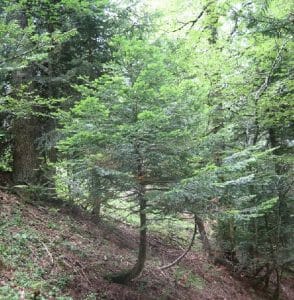Gravitropism Definition
Gravitropism, also called geotropism, where geo- means the earth, and tropism refers to turning, is the growth of a plant’s organ or change in the direction of its growth in response to gravity. Plants can sense gravity due to the presence of cells called statocytes, containing granules called statoliths, in their root cap, or the covering at the tip of the root. The statoliths are denser than the cytoplasm around them, and they stimulate the production of auxin, a hormone that is crucial for regulating plant growth. Gravitropism is one of a few forms of tropism, such as phototropism, where the direction of growth changes in response to light.
Gravity’s Influence on Roots and Shoots
Since plant cells are able to sense gravity, if a root is not growing towards the center of the earth, the cells become aware of that and change it. Normally, statoliths stimulate the production of auxin at the tip of the root, leading to downward elongation. However, when the growth is not in a downward direction, the cells react by creating a huge build up of auxin on the side of the root that is closer to gravity’s pull. This, in turn, inhibits cell elongation of the cells on the lower side but not the top, so that the horizontal root’s top cells grow larger than the ones at the bottom, and a curve appears, pointing downwards. Once the root tip is pointing towards gravity, the auxin concentrates at the tip and stimulates the growth of the cells downwards, enabling the root to reach more water and nutrients and achieve stability. We refer to this as positive gravitropism, because the root is growing in the direction of gravitational pull.
In contrast to roots, shoots curve upwards when they sense gravity’s pull. Normally, auxin is produced near the tip, and is transported down through the stem, stimulating the growth of all cells equally, so the stem grows upwards. If the plant falls over, the cells that are on the side that is closer to the ground are stimulated to produce auxin, leading to rapid growth of the cells closer to the center of the earth but not those away from it. This results in shoot curving upwards, as you can clearly see in the tree bark below. Like woody plants, herbaceous, or non-woody plants also show this characteristic. We call this negative gravitropism, because the shoot grows against the direction of gravitational pull.
In short, the accumulation of auxin in roots and shoots has opposite effects, since it leads to less growth in root cells, but more growth in shoot cells. If a plant in a pot is laid on its side, the growth of the main stem will start to curve into an upright position, away from the gravitational pull, and the roots will curve down towards gravitational pull. What is common, then, between roots and shoots, is that statoliths are always working to keep them as vertically aligned as possible.
Related Biology Terms
- Hydrotropism – The movement or growth of a part of a plant in response to moisture or water.
- Nastic movements – The non-directional movement or growth of a part of a plant in response to an environmental stimulus.
- Orthotropism – The movement or growth of a part of a plant in response to an environmental stimulus, where this growth is directly aligned with the stimulus.
- Thigmotropism – The change in orientation of a plant’s growth as a reaction to touch.
Quiz
1. Which of the following is the hormone that controls the growth of plant cells?
A. Statocyte
B. Statoliths
C. Auxin
D. Estrogen
2. Which of the following is true about plant gravitropism?
A. Plant shoots and roots both show positive gravitropism
B. Plant shoots and roots both show negative gravitropism
C. Plant shoots show positive gravitropism and roots show negative gravitropism
D. Plant shoots show negative gravitropism and roots show positive gravitropism
3. Which of the following allows plants to sense gravity?
A. Auxin
B. Statocytes
C. Chloroplast
D. Petioles
Gravitropism

No comments:
Post a Comment